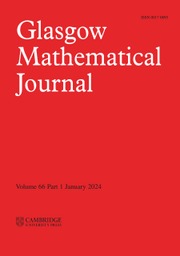No CrossRef data available.
Article contents
Equivariant category and topological complexity of wedges
Published online by Cambridge University Press: 15 September 2025
Abstract
We prove the formula \begin{equation*} \text{cat}_G(X\vee Y)=\max \{\text{cat}_G(X),\text{cat}_G(Y)\} \end{equation*}
\begin{equation*} \text{cat}_G(X\vee Y)=\max \{\text{cat}_G(X),\text{cat}_G(Y)\} \end{equation*} $X\vee Y$. As a direct application, we have that the wedge
$X\vee Y$. As a direct application, we have that the wedge  $\bigvee _{i=1}^m X_i$ is
$\bigvee _{i=1}^m X_i$ is  $G$-contractible if and only if each
$G$-contractible if and only if each  $X_i$ is
$X_i$ is  $G$-contractible, for each
$G$-contractible, for each  $i=1,\ldots ,m$. One further application is to compute the equivariant category of the quotient
$i=1,\ldots ,m$. One further application is to compute the equivariant category of the quotient  $X/A$, for a
$X/A$, for a  $G$-space
$G$-space  $X$ and an invariant subset
$X$ and an invariant subset  $A$ such that the inclusion
$A$ such that the inclusion  $A\hookrightarrow X$ is
$A\hookrightarrow X$ is  $G$-homotopic to a constant map
$G$-homotopic to a constant map  $\overline {x_0}\,:\,A\to X$, for some
$\overline {x_0}\,:\,A\to X$, for some  $x_0\in X^G$. Additionally, we discuss the equivariant and invariant topological complexities for wedges. For instance, as applications of our results, we obtain the following equalities:
$x_0\in X^G$. Additionally, we discuss the equivariant and invariant topological complexities for wedges. For instance, as applications of our results, we obtain the following equalities: \begin{align*} \text{TC}_G(X\vee Y)&=\max \{\text{TC}_G(X),\text{TC}_G(Y),\text{cat}_G(X\times Y)\},\\ \text{TC}^G(X\vee Y)&=\max \{\text{TC}^G(X),\text{TC}^G(Y),_{X\vee Y}\text{cat}_{G\times G}(X\times Y)\}, \end{align*}
\begin{align*} \text{TC}_G(X\vee Y)&=\max \{\text{TC}_G(X),\text{TC}_G(Y),\text{cat}_G(X\times Y)\},\\ \text{TC}^G(X\vee Y)&=\max \{\text{TC}^G(X),\text{TC}^G(Y),_{X\vee Y}\text{cat}_{G\times G}(X\times Y)\}, \end{align*} $G$-connected
$G$-connected  $G$-CW-complexes
$G$-CW-complexes  $X$ and
$X$ and  $Y$ under certain conditions.
$Y$ under certain conditions.
Keywords
Information
- Type
- Research Article
- Information
- Copyright
- © The Author(s), 2025. Published by Cambridge University Press on behalf of Glasgow Mathematical Journal Trust


